While the monarchy's approach to regulating commercial matters was guided, at least in part, by concerns with justice and taxation, it might be said that townsmen's interest in self-regulation of such matters was driven, again in part, by concerns with reputation: both their individual reputations as trustworthy traders and the reputation of the town itself, as a desirable place to live or do business (see for example the repeated concern expressed with the reputation of Ipswich in the proceedings establishing self-government there and in its custumal).
At a time when life was lived, to a larger extent than today, in the public eye, the way in which people behaved and acted reflected on their honour, their honesty, their credibility, their trustworthiness, and potentially on the community of which they were members. Those whose own characters were unknown (because, for example, of youth) would be judged on the basis of their social and family background; Margery Kempe played that card when, as a female travelling alone, she was interrogated by a suspicious mayor of Leicester and justified herself in a way the mayor would understand, by reference to her family connections. Reputation based on common opinion, expressed in the medieval term fama (although not much used in England, where the adjective 'common' as applied to occupations or behaviours may have connoted something similar) was a fragile commodity which might be based on knowledge and fact or susceptible to idle talk, rumour, or slander.
Cultivating a good reputation, through civil and well-mannered behaviour, could bring material benefit and lead to social advancement. Acquiring a truly bad reputation did not simply bring discredit, it implied lack of virtue and could adversely impact social status, material prospects, and ability to engage in business transactions, as well as candidacy for public roles of responsibility. This last began as low down the scale as selection of trial jurors and of capital pledges of the tithing system, householders being preferred and poor people being disqualified from service (on the assumption they were corruptible), while individuals who had a history of illicit or antisocial behaviours were likewise passed over. Individuals who were indicted or arrested for any offence could be released on bail if their reputation warranted it; but if convicted of some deceit, their reputation was lost and they were not to be released until they had paid their fines. Eligibility as guarantor, witness, prover of a will, or custodian of a minor could similarly be affected by loss of reputation. In the same way, an accusation levelled by an approver (one seeking to escape criminal punishment by informing on others) was rarely by itself sufficient to obtain a conviction. Holders of high borough office were generally tested through an 'apprenticeship' in lesser positions of responsibility first, except in a few cases where family reputation was sufficiently sound to warrant the scion's rapid advancement. It seems to have been a general expectation that only men of good reputations be elected to civic posts, on the assumption they were best qualified to uphold the high standards of performance indicated in their oaths of office; there was even a term coined to designate that category, or class, of citizen considered reputable.
The importance of reputation within society is indicated in a variety of ways. Other than homicides, most crimes were brought to light through complaints by victims or reports to the authorities by members of the public; at London (and likely elsewhere) citizens who were themselves law-abiding (according to their reputation) were authorized to apprehend suspected criminals and bring them before the authorities, and could call on public assistance via the hue-and-cry. That market offences might be punished by public shaming – whether placement in the pillory or public destruction of substandard goods before the seller's face – was aimed at harming the reputation rather than the person of the offender. One of the subsidiary functions of merchant and craft gilds seems to have been to keep disputes between members from deteriorating into public slanging matches that might reflect badly on the profession as a whole; tribunal-like meetings held by gilds sought to deal with such cases behind closed doors (e.g. Leicester and Reading ). Slander became a punishable offence and was taken particularly seriously when aimed at public officials (e.g. Bridgwater, Maldon). Claims of damage to reputation could also factor into lawsuits brought as a result of violent arguments between two parties involving insults made in public. In the Late Middle Ages we see a growing prejudice towards women as the source of defamatory talk, manifested as accusations against gossips and scolds. Motivation towards approved social behaviours stemmed partly from fear of notoriety or infamy, with its repercussions on the ability to participate fully in society.
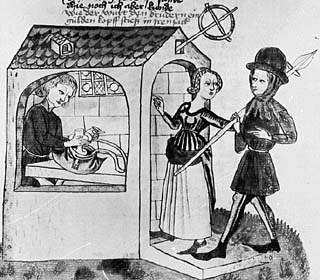
From the Schachzabelbuch, a German translation (1337),
of Cessole's De Ludo Scachorum
Several of the moral exempla in De Ludo Scachorum point
to the efficacy of shame, or fear of exposure, as motivation for individuals to avoid
bad behaviours, for in the society for which the chess-board is an allegory all the pieces
on the board can see and judge the actions of the others. This illustration shows
a hosteler's wife informing the authorities on a guest she accuses of stealing, although
it is in fact her husband who has planted the stolen goods among the possessions of the man
he is framing; the tale ends
when the hosteler's deceit is exposed, he confesses and is punished.
Common knowledge, opinion, or presumption – i.e. notoriety – about an individual's behaviour came into play through leet court administration, where the jury of capital pledges (themselves requiring good reputations) collectively made presentments of offences mostly committed against the community. This may be considered, to an extent, a form of self-regulation within a community, even though presenters were working from partially standardized lists of articles for investigation, which may have derived from the sheriff's tourn (although this was broader in scope) and perhaps acquired its authority partly from the Assize of Clarendon (1166). The scope of the London wardmoot sessions was fundamentally the same, although had broadened somewhat over time.
Comparison of the leet court (or equivalent) records from Colchester, Ipswich, Norwich and Lynn shows a fair degree of consistency in the types of offences addressed at each town, although these appear variant sub-sets of the lists of view of frankpledge articles that have surved to us. These offences were mainly public nuisances (such as creating obstacles or encroachments in streets, water-courses, or marketplaces), market offences, and minor assaults in which blood was shed, and less frequently offences such as hamsoken, unjustly raising hue and cry (something which could impact the reputation of the person targeted by the hue), or shoddy workmanship by tanners or, less often, other artisans. Much space in leet records is taken up with lists of those who brewed ale, baked bread, or retailed those products, in a fashion contrary to the assize, as well as those using false or unsealed weights or measures; forestalling and regrating were offences fewer in number but still regularly seen. Occasionally some small specification is given, such as: that in 1328 Reginald de Swerdestone's half-hundredweight weight was found to be a quarter-pound short; that vintner Robert Brunham had, over the course of 1402/03, sold 12 tuns of wine by retail, for which he was amerced 16s; and that Walter Baker of Colchester was accustomed (1380) to purchase corn with an over-sized bushel measure, then re-sell it using a regulation one.
These market offences do not seem to have had severe ramifications for reputation. Brunham's periodic convictions for regrating did not prevent him becoming a leader of Lynn's mercantile elite and attaining the mayoralty, and were probably not a major consideration in him becoming the focus for forceful opposition by a political faction. Nor were William Wyth's frequent convictions in the early fifteenth century, for various offences associated with operation of his hostelry, a bar to him subsequently being made a ward constable and going on to obtain a place on the town's upper council. John de Couteshale's unusually heavy fine in 1359 of 50s. for breaking the ale assize may have owed something to him being a repeat offender, but perhaps more to the fact he was at the time constable of the ward whose jury presented him, and would have been expected to set a better example; he was both a past and future mayor. Offences dealt with by the leet system were not generally scandalous, unless an offender was persistent or the offences were considered to have caused grave harm to the community. But the oversight of the leet courts may have served to keep a lid on excesses, and also alerted the public to be cautious in dealings with men identified as using false measures or other deceits in their business practices. Furthermore they were technically illegal and the community accepted its obligations to apply at least nominal punitive measures. Even when leet juries fingered women as scolds or prostitutes, this may not have damaged reputations, for the juries were probably only saying what was already common knowledge.
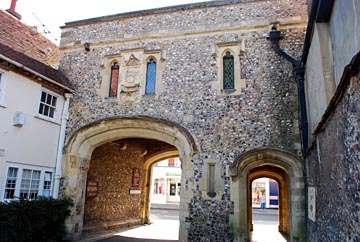
Canon Gate, Chichester, which gives access from the town to
the cathedral precinct. Believed built in the sixteenth century (though the plaque
installed with arms of an archdeacon of that period could be a subsequent addition)
its windows and parapet are later. The upper storey was used, probably from the time
of construction, for sessions of the piepowder court associated with the Sloe Fair.
In 1107 the bishop had received a licence for an 8-day fair in October, held in a field
outside the city's north gate. The civic authorities resented the extent of
episcopal jurisdiction in the city, particularly during fair-time. In 1407 the city's
mayor ordered citizens not to bring any suits in the bishop's piepowder court,
and imprisoned one of two citizens who defied this order; the bishop complained
that he had lost £100 in revenue as a result of the drop in judicial business and,
despite likely exaggeration, won some compensation. In 1500 the city received
royal licence for a short fair of its own, with power to hold a piepowder court
for the duration.
Photo © S. Alsford
Use of the judicial system for exerting a degree of self-regulation can also be argued for courts administering merchant law. When historians touch briefly on merchant law they emphasize its speedier procedures. Less attention is given to the fact that judgements were rendered by the community of merchants who were suitors to piepowder courts and (commensurate with a general legal principle) peers of the parties to disputes. Since most medieval trials were short on forensic evidence, reliance had to be placed on the credibility of the opposing parties and of witnesses, if there were any; at least one party to a trade dispute was likely to be an outsider. In the case of commercial disputes, the merchant suitors were the group most likely to be familiar with one or other of the parties to lawsuits – whether through experience in dealing with them or through hearsay knowledge of their characters or reputations; one or two might even have been witnesses to events recounted in the pleading. They were therefore best qualified to judge the plausibility of the arguments from the parties, just as they were best qualified to assess the severity of the case, appropriate punishment, and the validity of claims for losses or damages.
Merchant gilds have been criticized as monopolistic, which has some validity from the perspective of economics. But from the perspective of their role in social control, we have to keep in mind that the only real power gilds had over their members, ultimately, was the threat of deprivation of membership (and associated risk of ostracism from the community of merchants). To have teeth, such a threat required that membership have some real value; this was primarily in the form of restricting certain aspects of commerce to members. Gilds required members who came into dispute with one another to bring their grievances before the gild tribunal for resolution or arbitration, rather than to external courts where dirty linen would be aired more publicly; in front of their peers, some of whom were also relatives, occasional business partners or guarantors, and possible future executors, disputants were more likely to be brought to reconciliation than risk an expulsion which would deprive them of a useful source of business knowledge and networking connections. Borough authorities do not seem to have objected to this quasi-judicial role of merchant gilds, although at Norwich in 1290/91 the tanners' gild was presented by the leet court for settling disputes which ought to have been brought before the city bailiffs.
Another aspect of the informal regulatory role of merchant gilds, as well as craft gilds, was in influencing prices, even to the extent of price-setting. Members of merchant gilds had limited monopolies on retail of certain goods, although perhaps only outside the contexts of formal market sessions and fairs, and might well have colluded to fix prices. Craft gilds, with a clearer idea of the labour and materials costs involved in manufacturing products, and a virtual monopoly on their area of manufacture, were in an even better position to determine prices, set them for members, and police and enforce those prices; they were also concerned with setting wages that masters had to pay their journeymen, which impinged upon prices. Through membership they could control who, and how many, might practice their craft in a town, this having ramifications for supply, and thereby prices. This is not the kind of thing that tended to be explicit in the (relatively scarce) records of such gilds, and usually came to light in the form of complaints. In 1330, for instance, the Norwich chandlers were accused, as a group, of conspiring to fix a minimum price at which they would sell a pound of candles, while in 1382 it was presented at a Colchester lawhundred that the town millers had made an arrangement with the bakers that they would, at the time of local fairs, refuse to grind the grain of anyone but the bakers, thus giving the latter a monopoly on the bread trade and control over prices at times when it was in high demand; the bakers were acquitted following an enquiry.
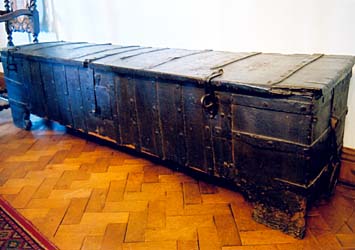
This oak 'evidence chest' was used by the Merchant Adventurers of York to hold
important gild records such as its charter of incorporation, register of members,
title deeds to properties owned by the gild, debt obligations, and perhaps
even the financial accounts of the gild. It may have been the iron-bound chest
recorded as purchased (perhaps second-hand) in 1436/37 for 6s.8d.
Photo © S. Alsford
In many towns merchant gilds faded from the scene, at least in terms of their role in commercial regulation, over the course of the Late Middle Ages. The advantages they offered were no longer as valuable, since Engish merchants were becoming more competitive on the international trading scene, in part due to (intermittently) protectionist policies of the Crown. Furthermore the interests of some of the larger categories of merchants were being addressed through national organizations, such as the Wool Staplers of Calais and what would become known, informally, as the Company of Merchant Adventurers of England, who were cloth merchants trading with Flanders and the Low Countries. The Adventurers (meaning simply merchants who engaged in overseas trading ventures) had at their core the London mercers, but were not restricted to the mercers, nor to London – there were branches at a number of larger towns, such as Norwich, Ipswich and York. As early as the thirteenth century the rulers of Flanders and Brabant had conceded recognition and privileges to this corporate group, which through its officials performed some of the same functions as urban merchant gilds, in terms of speaking on behalf of the collective membership, organizing communal expeditions to the great fairs, suppressing inappropriate behaviours of members (notably smuggling), supporting individual members who had commercial grievances with outsiders, and adjudicating disputes between members.
As a parallel development at York, between 1357 and 1361, when the wool trade was still dominant in the city's commerce, a fraternity of merchants and tradesmen (not restricted to York), under a title portraying itself as a socio-religiouis gild, built a large hall for their meetings, adding in its undercroft a hospital (with chapel) for poor and infirm men and women (recipients of members' alms-giving), and its own quay on the adjacent River Foss. The transition from wool export to cloth export as the foundation of English commerce favoured the Adventurers over the Staplers. In 1430 the York mercers, now the pre-eminent merchants of the city (despite the fact that the cloth industry was beginning to desert the city for the countryside) and the dominant force in the ranks of civic administrators, received a royal grant of incorporation for their gild. By this date the hall had become essentially the base of the mercers, for the socio-religious gild had altered its membership to eliminate non-merchants and members from outside the city.
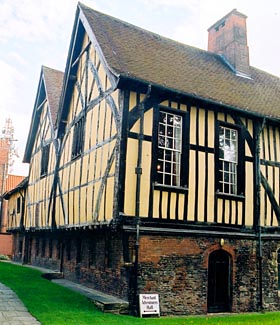
(above) The twin gables at one end of York's Merchant Adventurers Hall show its
great width.
(below) The interior of the hall, where the gild membership
held assemblies and feasts.
Photos © S. Alsford
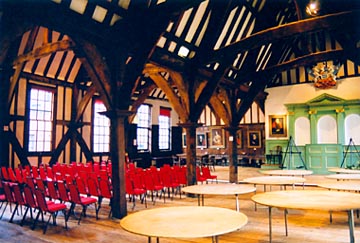
Company ordinances of 1495 (likely reiterating older provisions) required, on threat of 100s. fine, that no member sue another before giving the company officers a fortnight to try to resolve the dispute, and threatened with a fine any member who cursed another or argued with him in public. They regulated the mercery trade in York, limiting to members the right of keeping shops and prohibiting anyone from hawking merceries in the streets or at private homes, although the compnay could not prevent pedlars from selling merceries in the marketplace on official market days. Furthermore its searchers had the duty of checking the weights, ells, and measures used by mercers. It was partly the dominance of mercers in local government that made it possible for the company to play such a role in commercial regulation.
In 1580, sixteen years after Elizabeth I had granted incorporation to the Merchant Adventurers of England, York's company of mercers and merchants were re-incorporated as the Society of Merchant Adventurers of the City of York, separately administered from the London-based Adventurers.